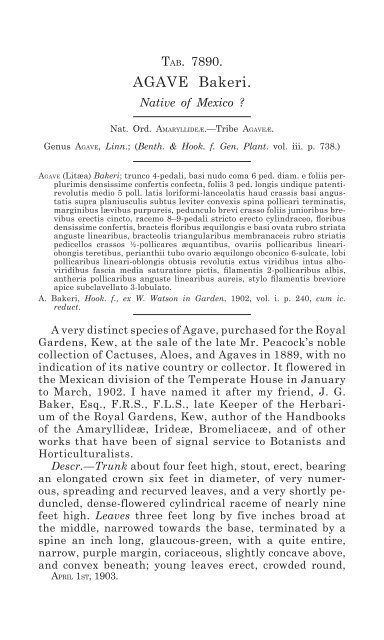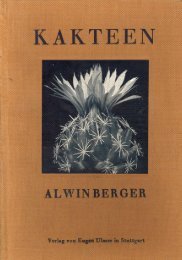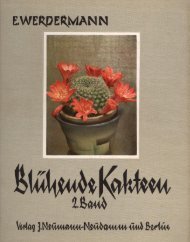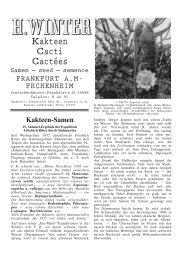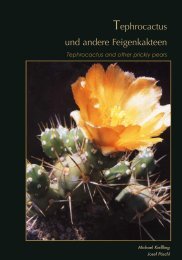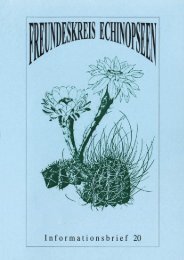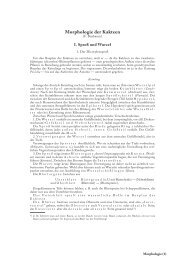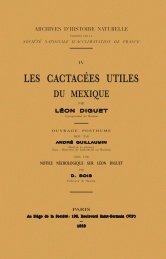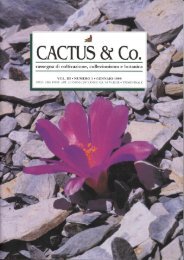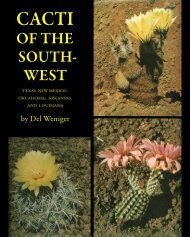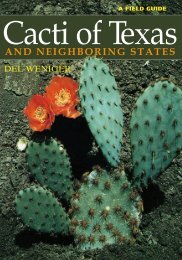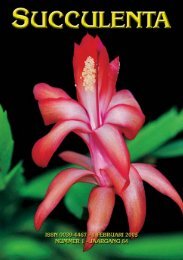- Page 1: This is a sample cover page
- Page 4: Olding, Esq., of the Peninsular and
- Page 7: little to the correct knowledge of
- Page 10: healthy offsets. The original plant
- Page 13: take to be merely a variety of the
- Page 16: lepidote on both sides, especially
- Page 19: anaceous, spinoso-dentate, red, mor
- Page 22: Peduncle erect, central, a foot lon
- Page 25: des c r . Acaulescent, stoloniferou
- Page 28: paratively soft and pliable in text
- Page 31 and 32: the health and vigour of the indivi
- Page 33 and 34: naturalized ever since the sixteent
- Page 35: Europe as that which is extracted f
- Page 40 and 41: Ta b . 5940. AGAVE bes s e r i a n
- Page 43 and 44: Ta b . 6248. AGAVE bo T T e r i. Na
- Page 46 and 47: Ta b . 7558. AGAVE bou c h e i . Na
- Page 49 and 50: Ta b . 8581. AGAVE b r a c T e o s
- Page 52 and 53: Ta b . 4934. AGAVE cel s i i . Cels
- Page 55 and 56: Ta b . 5716. AGAVE d a s y l i r i
- Page 58 and 59: Ta b . 5006. AGAVE d e n s i F l o
- Page 61 and 62: Ta b . 8451. AGAVE d i s c e p T a
- Page 63: 5 1 — ft. high, its peduncle abou
- Page 66 and 67: Mortol. 11, p. 859; non Jacobi. A.
- Page 69 and 70: Ta b . 8317. AGAVE Fra n z o s i n
- Page 71: subulate blackish-brown end-spine 2
- Page 74: eceived from Galeotti many years ag
- Page 77: large, scariose, linear from a dila
- Page 80 and 81: Mortola. It may therefore be accept
- Page 83 and 84: Ta b . 6589. AGAVE ho o k e r i. Na
- Page 86 and 87:
Ta b . 6511. AGAVE h o r r i d a .
- Page 89 and 90:
Ta b . 5893. AGAVE i x T l i o i d
- Page 92 and 93:
Ta b . 5097. AGAVE jac q u i n i a
- Page 95 and 96:
Ta b . 7532. AGAVE k e W e n s i s
- Page 98 and 99:
Ta b . 7477. AGAVE l a x i F o l i
- Page 101 and 102:
[ 1522 ] Agave lurida (a.) Broad‑
- Page 104 and 105:
Ta b . 5122. AGAVE m a c u l o s a
- Page 107 and 108:
Ta b . 8442. AGAVE m a r m o r a T
- Page 109:
ovate or deltoid fleshy cushion of
- Page 112:
a half feet high. It is a native of
- Page 115:
name takes precedence of Leichtlini
- Page 118:
at Kew within the last few years; t
- Page 121:
can be of very little service in sc
- Page 124:
while, according to the figure of t
- Page 127:
acutely keeled on the back, with ed
- Page 130:
young plant under the name of “A.
- Page 133:
lower half, a quarter of an inch th
- Page 136:
numerous thickish fibres, not elong
- Page 139 and 140:
Among the Agaves generally included
- Page 142 and 143:
Ta b . 8214. AGAVE WaT s o n i . Ce
- Page 145 and 146:
Tab. 8271. AGAVE Wri g h T i i. Cen
- Page 147:
des c r i p T i o n .—Trunk short
- Page 150:
nine to ten feet high, strict, rath
- Page 153:
tusely keeled beneath, the margin c
- Page 156:
perianth is described in that work
- Page 159:
lanceolate, a foot and a half long,
- Page 162:
Our drawing was taken, in July 1821
- Page 165:
without any flower, such as those q
- Page 168:
whole ſurface; and being whitiſh
- Page 171:
has lately received young plants fr
- Page 174:
with web‑like filaments, as in Se
- Page 178:
[ 1417 ] Aloe arachnoides (d.) tran
- Page 181:
A greenhouſe plant. Native of the
- Page 184:
of Miller’s original plant. It is
- Page 187:
from very imperfect material, that
- Page 190:
named A. hereroensis, crippled much
- Page 193:
shorter than the pedicels, pale gre
- Page 196:
which he collected between Urundi a
- Page 199:
angles to the margin, 1 — 6 - 1
- Page 202:
Leaves of a dark, ſometimes purpli
- Page 205:
a space of three or four inches in
- Page 208:
gradual increase in thickness from
- Page 211:
earing a few small lanceolate-delto
- Page 214:
good a genus, both in habit and flo
- Page 218 and 219:
Ta b . 6071. ALOE (ap i c r a ) d e
- Page 221 and 222:
[ 1332 ] Aloe depressa. Short‑lea
- Page 224 and 225:
( 1975 ) alo e F e r o x . gr e a T
- Page 227 and 228:
[ 1352 ] Aloe foliolosa. Small‑le
- Page 230 and 231:
Ta b . 6520. ALOE gre e n i i . Nat
- Page 233 and 234:
Ta b . 6863. ALOE h e T e r a c a n
- Page 236 and 237:
Ta b . 6981. ALOE hil d e b r a n d
- Page 239 and 240:
[ 757 ] Aloe Humilis. Soft‑Spined
- Page 242:
[ 828 ] Aloe‑Humilis (b). Narrow
- Page 245:
acts very small, ovate. Perianth cy
- Page 249:
See Note at Lingua 1332 [ 979 ] Alo
- Page 252:
Native of the Cape of Good Hope. On
- Page 256 and 257:
Ta b . 7448. ALOE lun T i i . Nativ
- Page 259 and 260:
Ta b . 6580. ALOE mac r a c a n T h
- Page 262:
[ 765 ] Aloe Maculata. Spotted Aloe
- Page 265:
chiefly in ſtature and in the grea
- Page 268:
(b.) minor. Supra No. 815. Decand.
- Page 271:
as A. supralaevis, b Hanburii, from
- Page 274:
For this very rare species, which i
- Page 278 and 279:
[ 1270 ] Aloe mitraeformis. Mitre A
- Page 281 and 282:
[ 1362 ] alo e mi T r æ F o r m i
- Page 284 and 285:
Ta b . 8147. ALOE n i T e n s . Sou
- Page 286 and 287:
torn plate
- Page 289 and 290:
Ta b . 8122. ALOE p a l l i d i F l
- Page 292 and 293:
Ta b . 7837. ALOE p e n d e n s . N
- Page 295 and 296:
[ 1338 ] alo e pe n T a g o n a . p
- Page 298:
[ 472 ] Aloë Perfoliata, var. Succ
- Page 301:
longer pedicels. Our first specimen
- Page 305:
[ 457 ] Aloe Plicatilis. Fan Aloe,
- Page 308:
furnished with copious ascending sc
- Page 311:
green colour; by its corolla not be
- Page 315:
[ 455 ] Aloe Retusa. Cushion Aloe.
- Page 318:
glaucous leaves with red ſpines, f
- Page 322 and 323:
Ta b . 7882. ALOE rub r o v i o l a
- Page 325 and 326:
[ 1346 ] Aloe saponaria (b.) satifo
- Page 328:
[ 1460 ] Aloe Saponaria(a). Common
- Page 331:
ginal teeth on the leaves, a compre
- Page 334:
ſpread more than thoſe of the for
- Page 337:
A. perfoliata. e; purpuraſcens; fo
- Page 340 and 341:
obscurity has had its origin in the
- Page 343 and 344:
Ta b . 6324. ALOE T r i c o l o r .
- Page 346:
[ 513 ] Aloe Variegata. Partridge
- Page 350:
[ 1355 ] Aloe virens. Apple‑green
- Page 353:
The caudex is completely covered by
- Page 357 and 358:
[ 1367 ] Anacampseros filamentosa.
- Page 360 and 361:
Ta b . 5087. APTERANTHES gu s s o n
- Page 363:
[ 788 ] Asclepias Carnosa. Thick‑
- Page 366:
of the corolla large, ovate, acute,
- Page 369:
distinguished from all the other sp
- Page 372:
adpressed lanceolate bract-leaves.
- Page 375:
texture of any known species of the
- Page 378:
authority of Mr. Wilson Saunders’
- Page 381:
erect raceme. Flower fascicled, two
- Page 384:
very thick, bi-convex; margins very
- Page 387:
of the flowers) branches, of a rich
- Page 390:
the root, spreading, recurved, abou
- Page 393:
teate, but without coma, nearly ses
- Page 396:
margined with small close brown hor
- Page 399:
des c r . Acaulescent, copiously st
- Page 402:
the runners; the inner become gradu
- Page 405:
loso-serrate; the colour darkish-gr
- Page 408:
an inch broad at the top of the dil
- Page 411:
with equally beautiful Orchidaceous
- Page 414:
des c r . Acaulescent. Produced lea
- Page 417:
meliads for a cultivator to obtain.
- Page 420:
and according to the information of
- Page 423:
them, bracteated, bracteas lanceola
- Page 426:
four to five feet long, dark-green,
- Page 429:
having a slightly reflected curvatu
- Page 432:
wards, and ending in a short acumen
- Page 435:
situations in Sicily, Spain, and th
- Page 438:
one; the species grow in dry places
- Page 441:
glandular pubescence, crisped, on s
- Page 444:
and are known as Hottentot’s brea
- Page 447:
extreme is exemplified in B. oianth
- Page 450:
The name was happily conceived by M
- Page 453:
two and a half to three inches long
- Page 456:
Pl. Afr. Austr. Extratropica, p. 30
- Page 459:
two inches long; tube cylindrical;
- Page 462:
acuminate, the inner oblong. Calyx
- Page 465:
nate tip. Peduncle stiffly erect, c
- Page 468:
Our drawing was made from a specime
- Page 471:
lanceolate, acute, falcate, thin in
- Page 474:
des c r . Stems tufted, branched fr
- Page 477:
Caralluma, with thirty-eight specie
- Page 480:
The species now described was disco
- Page 483:
slightly differing from Hoya, appea
- Page 486:
Morley Mission Station in the Trans
- Page 489:
of five, linear-subulate, pale-gree
- Page 492 and 493:
segments subulate, spreading. Corol
- Page 495 and 496:
( 3015 ) cer o p e g i a e l e g a
- Page 498 and 499:
Ta b . 8066. CEROPEGIA F u s c a .
- Page 501 and 502:
Ta b . 5306. CEROPEGIA gar d n e r
- Page 504 and 505:
( 3300 ) cer o p e g i a lu s h i i
- Page 507 and 508:
Ta b . 6927. CEROPEGIA mon T e i r
- Page 510 and 511:
( 4093 ) cer o p é g i a oc u l á
- Page 513 and 514:
Ta b . 5792. CEROPEGIA s a n d e r
- Page 516 and 517:
Ta b . 5578. CEROPEGIA s o r o r i
- Page 519 and 520:
( 3567) cer o p e g i a sT a p e l
- Page 522 and 523:
Ta b . 8458. CEROPEGIA Tho r n c r
- Page 525 and 526:
Ta b . 4758. CEROPEGIA ThW a i T e
- Page 528 and 529:
( 3740 ) cer o p e g i a vi n c æ
- Page 531 and 532:
( 3267 ) cer o p e g i a Wi g h T i
- Page 534 and 535:
Ta b . 7704. CEROPEGIA Woo d i i .
- Page 537 and 538:
[ 1436 ] Cotyledon crenata. Scollop
- Page 540 and 541:
( 2044 ) coT y l e d o n c u r v i
- Page 543 and 544:
( 2518 ) coT y l e d o n d e c u s
- Page 546 and 547:
Ta b . 7993. COTYLEDON e l e g a n
- Page 549 and 550:
Ta b . 5602. COTYLEDON F a s c i c
- Page 552 and 553:
Ta b . 8036. COTYLEDON i n s i g n
- Page 555 and 556:
Ta b . 6020. COTYLEDON m a m i l l
- Page 558:
[ 321 ] Cotyledon Orbiculata. Round
- Page 561:
Descr.—A small, very stout, flesh
- Page 564:
The specimen here figured of C. Pur
- Page 567:
one to three feet high; branches cy
- Page 570:
The Royal Gardens are indebted for
- Page 573:
name proposed by Dr. Rose. It has g
- Page 576:
C. teretifolia is rather an excepti
- Page 579 and 580:
the perianth more revolute, and the
- Page 582 and 583:
Ta b . 5684. COTYLEDON v e l u T i
- Page 585 and 586:
Ta b . 8421. CRASSULA bar k l y i .
- Page 588 and 589:
Ta b . 6194. CRASSULA b o l u s i i
- Page 591 and 592:
[ 1765 ] Crassula Centauroides. Cen
- Page 594:
[ 495 ] Crassula Coccinea. Scarlet
- Page 598:
( 1940 ) cra s s u l a c u l T r a
- Page 601:
A Greenhouse shrub, or more properl
- Page 605:
( 1771 ) cra s s u l a l a c T e a
- Page 608:
ultimate branches of the nerves ind
- Page 611:
Driekoppen, Zwaanepoetsport berge,
- Page 614:
crowns, linear-spathulate, subacute
- Page 617:
inclined or erect, as thick as a go
- Page 620:
and haW o r T h , also by sch u l T
- Page 623:
eighteen feet high, and another als
- Page 626 and 627:
much of the habits of very narrow-l
- Page 629 and 630:
Ta b . 6203. DECABELONE bar k l y i
- Page 632 and 633:
Ta b . 6115. DECABELONE e l e g a n
- Page 635 and 636:
Ta b . 4750. DICTYANTHUS p a v o n
- Page 638 and 639:
Ta b . 5795. DORSTENIA a r g e n T
- Page 641 and 642:
( 2476 ) dor s T e n i a a r i F o
- Page 644 and 645:
( 2760 ) dor s T e n i a ce r a T o
- Page 647 and 648:
( 2017 ) dor s T e n i a ho u s T o
- Page 650 and 651:
Ta b . 5908. DORSTENIA man n i i .
- Page 653 and 654:
Ta b . 7676. DORSTENIA phi i l l i
- Page 656 and 657:
( 2804 ) dor s T e n i a T u b i c
- Page 659 and 660:
Ta b . 8616. DORSTENIA yam b u y a
- Page 662 and 663:
Ta b . 6245. DUVALIA p o l i T a .
- Page 665 and 666:
Ta b . 7340. DYCKIA d e s m e T i a
- Page 668 and 669:
Ta b . 6294. DYCKIA F r i g i d a .
- Page 671 and 672:
( 3449 ) dyc k i a r a r i F l o r
- Page 674 and 675:
Ta b . 4986. ECHEVERIA c a n a l i
- Page 677 and 678:
( 3570 ) ech e v e r i a r a c e m
- Page 680 and 681:
Ta b . 8748. ECHEVERIA s e T o s a
- Page 683 and 684:
Ta b . 7760. ECHIDNOPSIS ben T i i
- Page 686 and 687:
Ta b . 5930. ECHIDNOPSIS c e r e i
- Page 689 and 690:
Ta b . 7929. ECHIDNOPSIS s o m a l
- Page 692 and 693:
Ta b . 5321. ECHINOSTACHYS pin e l
- Page 695 and 696:
( 2520 ) eup h o r b i a an a c a n
- Page 698:
( 2514 ) eup h o r b i a c a r i n
- Page 701:
seen the leaves nearly so broad in
- Page 704:
of our plant had in June, of its ap
- Page 707:
have been the product of the roots
- Page 710:
short, broadly ovate, greenish tube
- Page 714:
[ 883 ] Euphorbia Petiolaris. Long
- Page 718 and 719:
Ta b . 7971. EUPHORBIA v i p e r i
- Page 721 and 722:
Ta b . 8318. FOUQUIERIA s p l e n d
- Page 723:
or more axillary, panicled, narrow,
- Page 726:
destitute of teeth down the edges,
- Page 729:
what tortuose, about two feet long,
- Page 732 and 733:
quoted. It is this, too, that is so
- Page 735 and 736:
Ta b . 6148. FOURCROYA sel l o a .
- Page 738 and 739:
Ta b . 6160. FOURCROYA u n d u l a
- Page 741 and 742:
Ta b . 7170. FURCRÆA b e d i n g h
- Page 744 and 745:
Ta b . 8461. FURCRAEA e l e g a n s
- Page 747 and 748:
Ta b . 7250. FURCRAEA p u b e s c e
- Page 750 and 751:
( 2250 ) Fur c r œ a g i g a n T e
- Page 753 and 754:
7549 -> 7548 Ta b . 7548 GASTERIA F
- Page 756 and 757:
Ta b . 4607. GRAMMANTHES c h l o r
- Page 759 and 760:
Ta b . 6401. GRAMMANTHES c h l o r
- Page 762 and 763:
( 4087 ) gre e n óvi a aúre a . g
- Page 765 and 766:
Ta b . 5220. GUZMANNIA T r i c o l
- Page 768 and 769:
Ta b . 8828. HAWORTHIA cha l W i n
- Page 771 and 772:
Ta b . 7505. HAWORTHIA x i p h i o
- Page 774 and 775:
Ta b . 6348. HOODIA bai n i i. Nati
- Page 777 and 778:
Ta b . 8136. HOODIA cur r o r i . A
- Page 780 and 781:
Ta b . 6228. HOODIA gor d o n i . N
- Page 783 and 784:
Ta b . 5820. HOYA aus T r a l i s .
- Page 786 and 787:
Ta b . 4402. HOYA b e l l a . Beaut
- Page 789 and 790:
Ta b . 4545. HOYA c a m p a n u l a
- Page 792 and 793:
Ta b . 4347. HOYA c i n n a m o m i
- Page 795 and 796:
Tab. 4518. HOYA c o r i a c e a . C
- Page 798 and 799:
Ta b . 4969. HOYA c o r o n a r i a
- Page 801 and 802:
Ta b . 5148. HOYA c u m i n g i a n
- Page 804 and 805:
Ta b . 4684. HOYA F r a T e r n a .
- Page 807 and 808:
3397 -> 4397 Ta b . 6877. HOYA gri
- Page 810 and 811:
Ta b . 4397. HOYA i m p e r i a l i
- Page 813 and 814:
Ta b . 4826. HOYA (oTo s T e m m a
- Page 816 and 817:
Ta b . 5272. HOYA (oT o s T e m m a
- Page 819 and 820:
Ta b . 6682. HOYA l i n e a r i s .
- Page 822 and 823:
( 3425 ) hoy a po T T s i i . mr. p
- Page 825 and 826:
Ta b . 4520. HOYA p u r p u r e o -
- Page 828 and 829:
Ta b . 5269. HOYA she p h e r d i .
- Page 831 and 832:
Ta b . 7000. HUERNIA a s p e r a .
- Page 834 and 835:
Ta b . 6379. HUERNIA b r e v i r o
- Page 837 and 838:
Ta b . 7905. HUERNIA c o n c i n n
- Page 840 and 841:
Ta b . 6658. HUERNIA o c u l a T a
- Page 843 and 844:
505 should be 50? Ta b . 7730. HUER
- Page 846:
[ 1464 ] Jatropha integerrima. Spic
- Page 849:
the latter cernuous. Seed‑veſſe
- Page 852:
numerous, rather small, orange-red,
- Page 855:
green, fleshy. Corolla-tube obscure
- Page 858:
ounded or cuneate at the base, with
- Page 861:
half an inch long, terete, yellow b
- Page 864:
primary branches one to two inches
- Page 867:
often attaining a large size. Leave
- Page 870:
a cutting was received at the Royal
- Page 873:
marmorata was found, firstly in see
- Page 876:
crenate at the tip. Cyme very large
- Page 879:
fleshy, uniformly coloured on both
- Page 882:
face, slightly lepidote on the back
- Page 885:
dense above the base, oblong-cylind
- Page 888:
Hochst., figured at t. 6569 of this
- Page 891:
A dozen species of this fine genus
- Page 894:
down, one and a half or two feet lo
- Page 897:
eferred to the genus are regarded b
- Page 900:
diameter at one-third distance abov
- Page 903:
cylindrical, an inch and a quarter
- Page 906:
nate, white, membranous. Flowers ve
- Page 909:
in the cultivated plant, a quarter
- Page 912:
The specimen here figured was prese
- Page 915:
and Ireland. Our drawing was made f
- Page 918:
Peduncle slender, terete, as long a
- Page 921:
not very many years ago. K, Rooperi
- Page 925 and 926:
Ta b . 8867. KNIPHOFIA sno W d e n
- Page 928 and 929:
Ta b . 7644. KNIPHOFIA Tuc k i i .
- Page 931 and 932:
Ta b . 4816. KNIPHOFIA uva r i a .
- Page 934 and 935:
Ta b . 6553. KNIPHOFIA uva r i a va
- Page 937 and 938:
Ta b . 6435. LAMPROCOCCUS Wei l b a
- Page 940 and 941:
( 3289 ) mar s d e n i a Fl a v e s
- Page 943 and 944:
Ta b . 7953. MARSDENIA imT h u r n
- Page 946 and 947:
Ta b . 4299. MARSDENIA m a c u l a
- Page 949 and 950:
Ta b . 5539. MESEMBRYANTHEMUM a c i
- Page 952:
( 1824 ) mes e m b r y a n T h e m
- Page 956:
[ 70 ] Mesembryanthemum Barbatum. B
- Page 960 and 961:
Ta b . 6664. MESEMBRYANTHEMUM bol u
- Page 963 and 964:
Ta b . 6985. MESEMBRYANTHEMUM bro W
- Page 966 and 967:
Ta b . 6312. MESEMBRYANTHEMUM c o o
- Page 969 and 970:
[ 1220 ] Mesembryanthemum Densum. G
- Page 972 and 973:
Ta b . 8872. MESEMBRYANTHEMUM d i c
- Page 975:
[ 32 ] Mesembryanthemum dolabriform
- Page 978:
as an alien, and in those parts of
- Page 981 and 982:
an obovoid truncate corpusculum wit
- Page 983:
very compact clusters. The neat hab
- Page 986:
The redneſs of the leaves and bran
- Page 989:
thick as a sparrow quill, and like
- Page 993:
[ 1376 ] Mesembryanthemum minutum.
- Page 996:
plant shown in that drawing is agai
- Page 1000 and 1001:
Ta b . 8463. MESEMBRYANTHEMUM pea r
- Page 1003 and 1004:
Tab. 8703. MESEMBRYANTHEMUM pil a n
- Page 1006:
[ 540 ] Mesembryanthemum Pomeridian
- Page 1010 and 1011:
Ta b . 6299. MESEMBRYANTHEMUM suT h
- Page 1013 and 1014:
Ta b . 8595 a. MESEMBRYANTHEMUM T h
- Page 1015 and 1016:
Ta b . 8595 b. MESEMBRYANTHEMUM s T
- Page 1018 and 1019:
Ta b . 8674a. MESEMBRYANTHEMUM T r
- Page 1020 and 1021:
Tab. 8674b. MESEMBRYANTHEMUM T u b
- Page 1023:
( 2144 ) mes e m b r y a n T h e m
- Page 1026:
M. truncatellum was introduced into
- Page 1030 and 1031:
“cm” longi? -> “mm”? Ta b .
- Page 1033 and 1034:
Ta b . 8756. MONADENIUM e r u b e s
- Page 1035:
Boran countries in Abyssinia, attri
- Page 1038:
packages of tobacco. These ropes ha
- Page 1041:
of the leaves, which form a clearly
- Page 1044:
and thick stem scarred below with t
- Page 1047:
they respectively belong, affords a
- Page 1051 and 1052:
Ta b . 6606. PITCAIRNIA a l T a . N
- Page 1054 and 1055:
Ta b . 6480. PITCAIRNIA and r e a n
- Page 1057 and 1058:
[ 1547 ] Pitcairnia angustifolia. N
- Page 1060 and 1061:
[ 1416 ] Pitcairnia bracteata (b.)
- Page 1063:
[ 824 ] Pitcairnia Bromeliæfolia.
- Page 1066:
oad at the middle, tapering gradual
- Page 1069:
furfuraceous, terete. Pedicels abou
- Page 1072:
entire, glabrous, a part of the upp
- Page 1075:
floccose, bracteated by three or fo
- Page 1079 and 1080:
Ta b . 4540. PITCAIRNIA jac k s o n
- Page 1082 and 1083:
[ 856 ] Pitcairnia Latifolia. Broad
- Page 1085 and 1086:
Ta b . 4705. PITCAIRNIA m a c r o c
- Page 1088 and 1089:
Ta b . 4770. PITCAIRNIA m u s c o s
- Page 1091 and 1092:
Ta b . 5356. PITCAIRNIA p u n g e n
- Page 1094 and 1095:
Ta b . 7966. PITCAIRNIA s p a T h a
- Page 1097 and 1098:
( 2411 ) piT c a i r n i a sT a m i
- Page 1100 and 1101:
Ta b . 8410. PITCAIRNIA T a b u l a
- Page 1103 and 1104:
Ta b . 4241. PITCAIRNIA u n d u l a
- Page 1106 and 1107:
Ta b . 6535. PITCAIRNIA ze i F o l
- Page 1109 and 1110:
Ta b . 5081. PLOCOSTEMMA l a s i a
- Page 1112 and 1113:
( 2885 ) por T u l a c a g r a n d
- Page 1115 and 1116:
Ta b . 4309. PUYA a l T e n s T e i
- Page 1118 and 1119:
Ta b . 4715. PUYA chi l e n s i s.
- Page 1121 and 1122:
Ta b . 5234. PUYA g r a n d i F l o
- Page 1124 and 1125:
Ta b . 4696. PUYA s u l p h u r e a
- Page 1127 and 1128:
Ta b . 8194. PUYA v i o l a c e a .
- Page 1129:
etc. They do not suffer if kept dry
- Page 1132:
somewhat imbricating bracts, which
- Page 1135:
lood-colour, broad lanceolate, shar
- Page 1138:
de s c r . Stems very short and bra
- Page 1141:
glabrous face, persistently white-l
- Page 1144:
insigne,” but these appear to us
- Page 1147:
It flowered both in the Royal Garde
- Page 1150:
known species, a native of the moun
- Page 1153:
tatum to it. He had picked it up, a
- Page 1156:
sea-level, S. pilosum is quite hard
- Page 1159:
abruptly ascending from the base, f
- Page 1163 and 1164:
Ta b . 5358. SEDUM sie b o l d i i
- Page 1166 and 1167:
Ta b . 7908. SEDUM sTh a l i i . Na
- Page 1169 and 1170:
( 1977 ) sed u m T e r n a T u m .
- Page 1172:
[ 68 ] Sempervivum arachnoideum. Co
- Page 1176 and 1177:
( 2115 ) sem p e r v i v u m g l o
- Page 1179 and 1180:
( 1963 ) sem p e r v i v u m g l u
- Page 1182 and 1183:
Ta b . 6610. SEMPERVIVUM m o g g r
- Page 1185:
[ 93 ] Sempervivum Monanthes. Dwarf
- Page 1188:
ought away several plants, some of
- Page 1192 and 1193:
[ 1457 ] Sempervivum soboliferum. H
- Page 1195 and 1196:
Ta b . 6055. SEMPERVIVUM T e c T o
- Page 1198:
[ 296 ] Sempervivum Tortuosum. Gout
- Page 1201:
many, rosulate on the top of the st
- Page 1205:
[ 536 ] Stapelia Asterias. Star‑F
- Page 1208:
that though recorded as distinct by
- Page 1212 and 1213:
( 4127 ) sTa p é l i a c a c T i F
- Page 1215:
[ 1227 ] Stapelia Campanulata. Bell
- Page 1219 and 1220:
Ta b . 6082. STAPELIA cor d e r o y
- Page 1222:
[ 1007 ] Stapelia Divaricata. Strad
- Page 1226 and 1227:
[ 1326 ] sTa p e l i a g e m i n a
- Page 1229 and 1230:
( 1839 ) sTa p e l i a ge m m i F l
- Page 1232 and 1233:
Ta b . 8681. STAPELIA geT T l e F F
- Page 1235 and 1236:
Ta b . 7068. STAPELIA gig a n T e a
- Page 1238 and 1239:
[ 585 ] Stapelia Grandiflora. Great
- Page 1241 and 1242:
Ta b . 5751. STAPELIA hys T r i x .
- Page 1244 and 1245:
Ta b . 8561. STAPELIA lee n d e r T
- Page 1247:
[ 506 ] Stapelia Lentiginosa. Freck
- Page 1250:
As jac q u i n received his plant f
- Page 1253:
trabeculate with blood-red cross-li
- Page 1256:
sometimes pale olive ground; lobes
- Page 1260 and 1261:
[ 1169 ] Stapelia Picta. Painted St
- Page 1263 and 1264:
Ta b . 5692. STAPELIA pla n T i i .
- Page 1266 and 1267:
[ 1648 ] Stapelia pulla. Black‑fl
- Page 1269:
[ 1240 ] Stapelia Pulvinata. Cushio
- Page 1272:
anther, or in the language of Swart
- Page 1276:
[ 1662 ] Stapelia reticulata. Nette
- Page 1280 and 1281:
Ta b . 5963. STAPELIA s o r o r i a
- Page 1283:
( 2037 ) sTa p e l i a sT r i c T a
- Page 1287:
[ 786 ] Stapelia Verrucosa. Warty
- Page 1290:
cylindric, woody, one to two inches
- Page 1293:
Three species (together with C. cal
- Page 1297 and 1298:
Ta b . 7121. TILLANDSIA (vri e s e
- Page 1300 and 1301:
Ta b . 4288. TILLANDSIA b u l b o s
- Page 1303 and 1304:
Ta b . 6906. TILLANDSIA c h r y s o
- Page 1306 and 1307:
Ta b . 6882. TILLANDSIA (Vriesea) i
- Page 1309 and 1310:
Ta b . 5892. TILLANDSIA (piT y r o
- Page 1312 and 1313:
Ta b . 6945. TILLANDSIA jon g h e i
- Page 1315 and 1316:
Ta b . 5850. TILLANDSIA lin d e n i
- Page 1318 and 1319:
Ta b . 6495. TILLANDSIA mal z i n e
- Page 1321 and 1322:
Ta b . 7320. TILLANDSIA m i c r o x
- Page 1324 and 1325:
( 2841 ) Til l a n d s i a p s i T
- Page 1327 and 1328:
Ta b . 5229. TILLANDSIA p u l c h e
- Page 1330 and 1331:
[ 1732 ] Bromelia pyramidalis. Pyra
- Page 1333 and 1334:
Ta b . 5246. TILLANDSIA r e c u r v
- Page 1336 and 1337:
( 3275 ) Til l a n d s i a se T a c
- Page 1339 and 1340:
Ta b . 6757. TILLANDSIA s T r e p T
- Page 1342 and 1343:
[ 1529 ] Tillandsia stricta. Froste
- Page 1345 and 1346:
Ta b . 6309. TILLANDSIA u s n e o i
- Page 1348 and 1349:
Ta b . 8579. TRICHOCAULON p i c T u
- Page 1351 and 1352:
Ta b . 6759. TRICHOCAULON p i l i F
- Page 1354 and 1355:
[ 744 ] Tritoma Media. Glaucous‑L
- Page 1357:
[ 764 ] Tritoma Pumila. Lesser Trit
- Page 1361 and 1362:
Ta b . 5472. VITIS bai n e s i i .
- Page 1364 and 1365:
Ta b . 5479. VITIS m a c r o p u s
- Page 1367:
Ta b b . 5368, 5369. WELWITSCHIA m
- Page 1370 and 1371:
ney of about thirty miles into the
- Page 1372:
Ta b. 5368.—Fig. 1. Copy of the d
- Page 1375:
There are wild specimens in the Kew
- Page 1378:
ground, and to flower there much ſ
- Page 1382 and 1383:
Ta b . 5201. YUCCA c a n a l i c u
- Page 1385 and 1386:
Ta b . 7650. YUCCA e l a T a . Nati
- Page 1388:
[ 900 ] Yucca Filamentosa. Thready
- Page 1391:
drawn is very remarkable. The trunk
- Page 1395 and 1396:
[ 1260 ] Yucca gloriosa. Superb Ada
- Page 1398 and 1399:
Ta b . 7997. YUCCA g u a T e m a l
- Page 1401 and 1402:
Ta b . 6316. YUCCA o r c h i o i d
- Page 1404 and 1405:
Ta b . 7172. YUCCA r u p i c o l a
- Page 1407:
( 2222 ) yuc c a s T r i c T a . ly
- Page 1410:
that ripe seeds of this Yucca were


